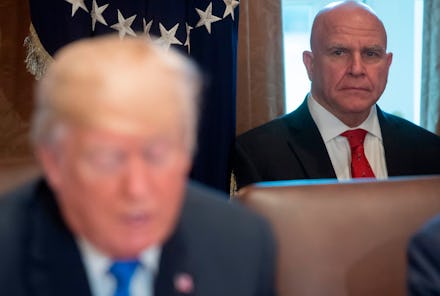Trump administration reportedly considering “bloody nose” military strike against North Korea

Could the United States conduct a military strike on North Korea without the situation escalating into all-out war?
That’s a question the White House is considering, according to the Wall Street Journal, which reported Tuesday that the Trump administration is considering whether a targeted strike could show Pyongyang that Washington means business without resulting in retaliation from the nuclear-armed country against the U.S. or South Korea.
The move would be part of a so-called “bloody nose” strategy, that, in theory, could demonstrate the extent of U.S. military might against the isolated nation, according to the Journal. It’s believed such a move may serve as a deterrent for North Korea’s nuclear provocations.
Using a “bloody nose” strategy, a strike could be conducted in reaction to another North Korean weapons test, the Journal reported. But it would also be “dangerous,” according to Jeffrey Lewis, director of the East Asia Nonproliferation Program at the Middlebury Institute of International Studies at Monterey.
“If the U.S. conducted a strike, Kim Jong Un would feel compelled to escalate,” Lewis said in an interview with Mic on Tuesday. “That will spark a crisis that might get out of control.”
President Donald Trump’s national security adviser H.R. McMaster could be one of the driving forces behind such a move, the Journal’s Gerald F. Seib suggested. McMaster publicly remarked on the possibility of using military force on the peninsula in April, and he starkly warned in December that the potential for nuclear war was “increasing every day.” He also called North Korea is “the greatest immediate threat to the United States.”
The talk coming from McMaster and others in the administration is likely a “bluff,” Lewis said. But there could be real consequences to the rhetoric.
“I think there is a danger that talk like this might have its own momentum, especially in a crisis,” Lewis said. “And even if the Trump administration doesn’t execute a strike, simply talking about it may make other dangerous ideas seems reasonable by comparison.”
North Korea and South Korea conduct “formal dialogue”
Reports of the possible military strike came on the same day North Korean and South Korean officials engaged in 11 hours of formal talks in the demilitarized zone between the two countries. These were the first such discussions in over two years.
During the talks, North Korea objected to the South’s call to denuclearize, but the two nations agreed to engage in further negotiations that could hopefully ease tensions on the peninsula. It is unclear when future discussions will take place.
Fears of nuclear war have been high as Pyongyang continues its nuclear testing in defiance of international calls to cease its weapons program.
North Korea conducted more than a dozen nuclear tests throughout 2017, including an intercontinental ballistic missile launch in November that landed near the Japanese coast and appeared capable of reaching the U.S. mainland.
Meanwhile, a war of words between Trump and Kim have added to the tensions, leading to worries that heated rhetoric between the two leaders could lead to a deadly conflict.
On New Year’s Day, Kim taunted the U.S. with a nuclear button he said is on his desk. Trump responded days later with a controversial tweet in which he claimed his nuclear button is “much bigger [and] more powerful.”
Some observers, however, expressed hope when Kim recently opened a long-dormant communications channel with South Korea to discuss the 2018 Winter Olympics, which will begin in Pyeongchang, South Korea, in February. That move signaled a possible path to a nuclear deal between Kim and South Korean President Moon Jae-in, who took office in 2017.
The opening of a line of communication also showed both sides are concerned about a lack of clear direction by the Trump administration, according to Dr. Waheguru Pal Singh Sidhu, a clinical associate professor at the New York University School of Professional Studies Center for Global Affairs.
“The fact that this step has been taken showed that both Pyongyang and Seoul are concerned about the lack of coherent policy from the U.S. and are trying to do their bit to reduce bilateral tensions,” Sidhu said in an email interview. “However, this is unlikely to resolve the long-term conflict. That will need the participation of at least the U.S. and China, if not Japan and Russia as well.”
So far, the Trump administration has had a disjointed response to tensions on the Korean peninsula. Secretary of State Rex Tillerson has promoted diplomatic solutions, but Trump has undercut him by repeatedly mocking Kim on Twitter and suggesting Tillerson is “wasting his time” in pursuing negotiations with Pyongyang.
But on Saturday, the president suggested he might favor diplomacy. He credited his harsh, often bullying bluster against Kim for the burgeoning talks between Pyongyang and Seoul and told reporters he’d “absolutely” be willing to meet with his North Korean counterpart.
“I always believe in talking,” Trump said in a press conference.
The report of discussions about a possible “bloody nose” strike against North Korea, however, suggests administration officials may lack confidence in North Korean and South Korean officials finding a solution.
Tuesday’s talks did yield at least one concrete result: Pyongyang announced it would send a delegation to the Olympics in February, during which South Korea and the U.S. will suspend military exercises in the region.
But it remains unclear what will happen beyond that, as the U.S. has so far predicated negotiations on North Korea abandoning its nuclear program — something Kim’s regime continues to refuse.